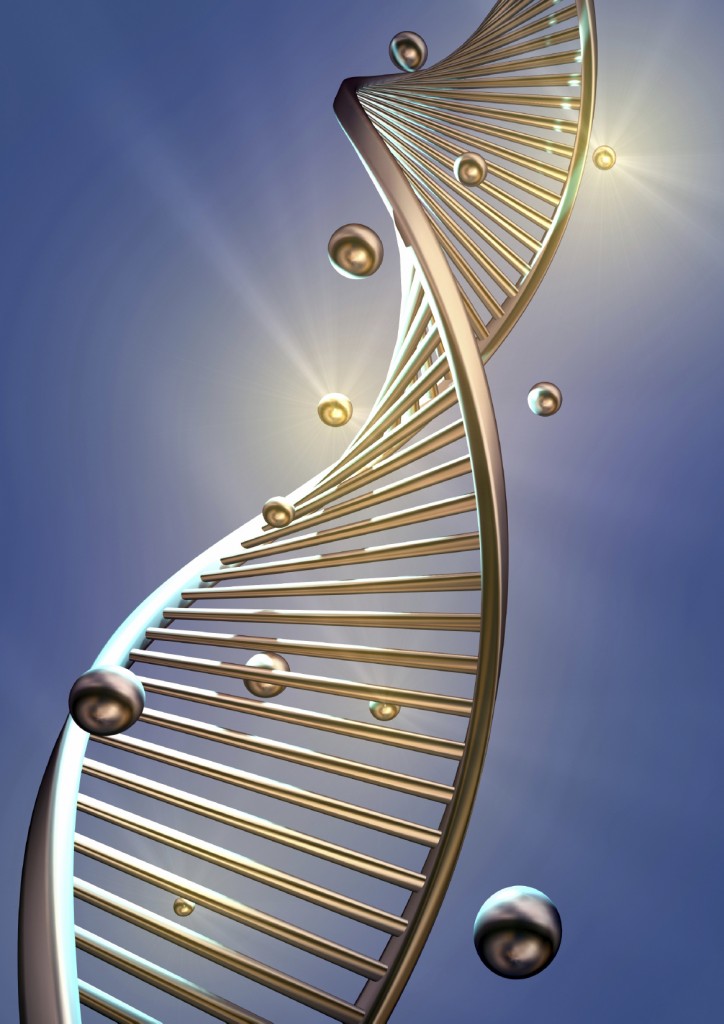When interviewing potential hypnosis clients, a frustration weight loss candidates will occasionally bemoan is the observation that some of their friends seem to be able to eat enormous amounts of food, yet stay skinny, skinny, skinny. “It seems like when Karen eats, I’m the one who gets fat!” It just doesn’t seem fair.
Often we ascribe this phenomena to our genetics. While it does appear that obesity often does run in families, are you really condemned by the structure of your DNA to struggle with weight? Not necessarily. Recent scientific research suggests that the expression of your DNA can actually be modified by your mind!
Let’s examine excess fat accumulation. All of your body’s functions really do have useful purposes – including fat storage. Unused energy, retained as fat, evolved as an energy reserve for when food is scarce. But today, for most Americans, food is plentiful, activity is low and the very mechanism that helped your ancestors to thrive, is maladapted for your living conditions. The very survival mechanism that was once an evolutionary advantage, now needs a bit of an adjustment. There are many factors that can change the way your body metabolizes food, but one that is often overlooked, and that you may wish to consider, is the modification process of your genetic code.
But How? After all, isn’t your genetic inheritance, that permanently fixed graph of kaleidoscopically selected DNA from your ancestors’ characteristics, inalterable? How can the expression of a DNA pattern actually be modified to accommodate modern conditions without the benefit of actually revising the code? In short, exactly how can I change my own genetic imprinting?

A relatively new field of genetic study, called “epigenetics,” is considering the mechanics of gene expression and modification. Epigenetics recognizes environmental elements as the antecedents of cell development and variety, taking outside factors into account as the cause of change in the expression of DNA rather than actual alteration of the DNA code itself.
In an experiment by Dr. Bruce Lipton, author of “The Biology of Belief,” DNA from a single cell was placed into a petri dish. Dividing that cell until there were thousands of identical cells, and then placing them in three different dishes, he manipulated the culture medium (environment) differently in each one. In one dish the cells became bone, in another muscle, and in the third fat!
Dr. Lipton’s experiment demonstrates that the DNA inside the cell’s nucleus requires something outside of itself to tell it which genes to activate. The DNA is the “blueprint,” not the actual structure. The structure is regulated by cell protein, and the cell develops its shape only after gene selection is made. Chemical elements make that selection. Molecular attachments, or epigenetic tags, particularly those in the methyl group, fasten themselves to the DNA strand acting as markers to indicate which genes will be silenced and which will be expressed.
The significance of Dr. Lipton’s experiment is that it proves that it’s the chemical environment, not just the genetic code, that determines the fate of the cells. With each cell holding a capacity of about thirty thousand variations, your cells are quite capable of readjusting to new conditions.
And what determines the chemical environment of your body? Everything from the food you eat, the air you breathe and, quite significantly, the chemical emissions of your brain – including those elicited by your emotions!
Your brain sends and receives chemical signals, according to your perceptions, through your nervous system. The nervous system, in turn, adjusts automatically to this environment secreting hormones through your bloodstream that eventually reach the nucleus of the cell – where your DNA is located. What this means to you is that the trillions of cells in your body, heavily influencedby your brain, can regenerate in a different, and possibly more favorable, environment depending on how you view and experience the world!
This is where epigenetics really becomes interesting. Originally, it was believed that epigenetic tags were established only during fetal development. And then only after a process of reprogramming, or erasing, the previous tags, creating a genetic “clean slate.”
But now it is believed that molecular attachments to DNA can be added or subtracted all the way into adulthood. Mental and physical input, initiating chemical signals that travel from cell to cell, activate your DNA in a continuous transmogrification of diverse combinations. When stabilization of an epigenetic tag occurs, the expression of the DNA is implemented accordingly. And further, scientists also acknowledge that some imprinted epigenetic tags slip through the reprogramming process, getting passed down from one generation to the next.
Anecdotal observation seems to support this hypothesis. It has long been recognized that obese mothers have a higher risk of producing obese children. However, it is noteworthy to mention that mothers who lose weight reduce their children’s risk of obesity. A plausible explanation for this can be found in the field of “behavioral epigenetics.”
Behavioral epigenetics has taken the study one step further to acknowledge that even those epigenetic tags produced by the mental and emotional states of your ancestors may be among those passing through the DNA reprogramming process of early development. From this view, if traumatic experiences in adulthood induced methylated attachments that fixed themselves to your grandmother’s DNA, then you may have inherited the same epigenetic tags to your DNA.
The good news? Better environmental conditions can dispose of an unfavorable molecular attachment inherited from a previous generation. If an epigenome is incongruent with its current environment, it detaches. That’s right. It just goes away. If this point should become fodder for that never-ending debate as to which is the most important, nature or nurture – in this case, nurture wins! A change in perceptions can ignite feelings producing chemical emissions that, ultimately, create an environment for release of those epigenetic tags that do not resonate with that change. It may either prompt activation of genomes in your DNA that were previously silenced, or silence those that were active.
It makes no difference whether you create a negative or positive environment, your DNA it will actuate according to the directions it’s given. The principle works either way.
Rather than blaming your DNA, work with it. Your genetic potential is greater than you think. Because your DNA is influenced by the chemistry of your body, and your body chemistry by your mind, scientists now believe the power of your mind can alter the way your body responds right down to the cell level.
So, if the mind has such a powerful effect on brain chemistry and cell development, then why is it that practicing affirmations and keeping a positive attitude has such a minuscule effect on physiological or behavioral change?
This is because most affirmations and positive thinking disciplines are practiced in the conscious mind. To make a integral change, you need to engage the overriding, creative, controlling, operative part of your mind. The part of your mind that automatically keeps your body working in sync. That keeps your heart beating. That keeps your digestive and fluid systems working. That lets you breathe without thinking. The part of the mind that compels the healing process. And that regulates your body’s chemistry. The subconscious.
It’s your subconscious that dominates 95% of your mind. It operates under the radar of your awareness and cannot be “convinced” through logical argument. Your subconscious holds your deepest beliefs, core values, memories, experiences, habits and emotions. And its the beliefs held in this part of your mind that need to be revised if you want to obtain permanent or profound change. If 95% of you believes that you will always be fat, then the 5% of your conscious mind that declares you can be thin is just outgunned. The subconscious mind also generates your automatic responses. That is why you can tell yourself not to blush, but you still blush (much to your embarrassment.) So to make a substantial change in your behavior and automatic responses, you will need to negotiate with your subconscious mind on its own terms.
This is how hypnosis helps countless numbers of people to lose weight every year. Hypnosis accesses the habits, beliefs, emotions and the automatic responses retained in the subconscious mind. Hypnosis allows you to gain entry to this part of your mind so you can then communicate with it in a way that the subconscious can understand. There is a specific language that the subconscious mind comprehends. Emotion, experience and imagination – the language of the subconscious mind – is directed toward the desired outcome during the hypnosis session. As the subconscious accepts hypnotic suggestion, it scans its vast gallery of resources to focus them toward your desired goal. In the case of weight loss, as hypnotic suggestion takes effect, the subconscious will begin to support your decision for healthy eating by increasing your attraction to light and nutritionally dense foods; by prompting hunger and appetite satiation signals appropriately; by reducing cravings; and by making junk food less alluring.
Hypnosis instills good habits, too, like getting proper amounts of exercise and rest; increasing consumption of water; eating slowly and consciously; and becoming free of stress and self-sabotaging behaviors. And, of course, a change in your mental and physical habits stimulates change in your brain chemistry – that fascinating environmental precursor to epigenetic attachment and DNA activation. It’s important to note that your thoughts, actions, perceptions and habits all have an impact on brain and body chemistry. Weight issues are complex, and there is no single component that regulates how your body gains or loses weight – including your DNA – but many of the factors that regulate weight loss can be induced while in hypnosis.
Notice that I mentioned “habits” – an essential component of successful weight loss! I cannot overstate this: a healthy lifestyle is crucial for permanent weight loss! Successful weight loss is not about going on diets. Although many people lose weight on diets, they are not really successful in that most people (about 95% in fact) gain it all back plus some after the diet is over! The only successful weight loss is the one that you get to keep forever.
To effectively change your body’s ability to lose weight, you must change your relationship with eating and exercise. Then and only then can you establish thin habits that become automatic for you. As your body and weight conform to a new set point, the same attitudes and habits that helped you to take it off will help you to keep it off for a lifetime. Your subconscious mind continues working for you, because now your core beliefs, habits and perceptions are different. Your automatic reactions are different. Your associations with food are different. Your mind no longer connects a compelling expectation to those old sources of unwanted behavior and, consequently, your brain’s responses to them wane away. Your subconscious mind no longer incites those unhealthy desires and compulsions.
Food, exercise, medications and many other factors affecting the chemical environment of your DNA do, of course, have an impact on cell development. But do not underestimate the power of your emotions and attitudes. Perceptions, emotions and automatic responses are all registered as brain chemicals and those chemicals have an effect on the way your DNA is expressed and on how your body performs. Stress, for example, has long been recognized as a prime suspect when addressing weight fluctuation issues.
Hypnosis works with you by persuading your subconscious mind to accept new habits, beliefs, attitudes and automatic responses. New perceptions are established as your self image, attitude and disposition shift in concurrence. These new positive perceptions are reflected in the brain through chemical emissions and, consequently, in the DNA – where molecular attachment and genetic expression adjust for a new and better version of you.
Changing your eating and exercise habits are, and always will be, an important mainstay of any healthy weight loss program. However, it appears that science is now validating an awareness long known in spiritual circles: that a change in your mental body prompts correspondence in your physical body. It’s worth considering that perhaps by allowing perceptual change to take place in your subconscious mind, you create a new chemical environment for your DNA. And that new environment may very well be a catalyst for the promotion of long-term weight loss.
So are you stuck with your parents’ and grandparents’ genetic predisposition? Like a hand-me-down dress, if you like it “as is” then keep wearing it that way. But if you want a better fit, or would prefer a slightly different design, then just a few minor alterations can get you a whole new look!

